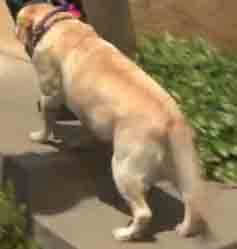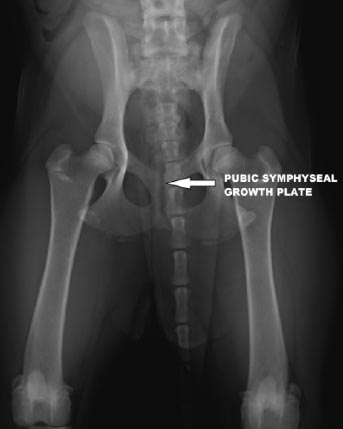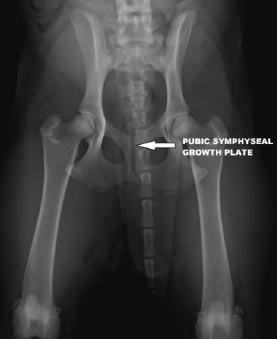Summary:
"Canine or Dog Hip Dysplasia (CHD or HD) is a condition where the ligaments, muscles and connective tissue that control and support the hip no longer keep it in place (called hyperlaxity).
The problem is common in dogs, affecting approximately 25% to 30% of all pets. Symptoms associated with canine hip dysplasia include loss of mobility, lameness, and pain. When symptoms appear in puppies, it rarely occurs before age 4 to 5 months but can develop as early as age 5 to 9 months. In some dogs, symptoms become noticeable during age 3 to 5 years.
Symptoms include signs that your dog is avoiding any physical activity such as standing up, playtime, or walks in the park. Another sign is a change in your dog's gait, where he or she "bunny hops" instead of using a normal walking motion.
Veterinarians try and diagnose the disorder early to prevent secondary problems such as abnormal joint remodeling and osteoarthritis. Treatment includes conventional approaches such as weight loss, exercise, heat therapy, and prolotherapy, which involves the use of vitamin B12 or dextrose injections combined with lidocaine. While this dog hip problem cannot be prevented, the impact of the disease can be reduced by knowing the incidence of the disorder in your breed, and through proper nutrition and by maintaining the ideal body weight."
What is Dog Hip Dysplasia?
Dog Hip Dysplasia (CHD, canine hip dysplasia) occurs when the hip joint, which is a 'ball and socket' joint fits loosely together. The disorder is due to a laxity of the ligaments, muscles, and connective tissue, which holds a dog's hip in place.
The end of the femur (the thigh bone) ends in a 'ball' and should fit snugly into the 'socket' of the pelvic bone. In dogs with hip dysplasia, the bones fit together loosely. When the hip forms abnormally, the cartilage that holds the joint together wears prematurely. The laxity in the joint leads to the onset of a form of arthritis called degenerative joint disease (DJD) or osteoarthritis.
Treatment methods include hip replacement, triple pelvic osteotomy (TPO) and Juvenile Pelvic Symphysiodesis (JPS.)
Hip dysplasia is a developmental disease. It isn't present when your dog is born, but develops later in life. It is rarely seen in dogs under five months of age and often does not result in clinical signs or symptoms until age 3 to 5 years old.
It is a genetic dog hip problem with some breeds having a higher incidence than others. The disorder is widespread, with 25% to 30% of dogs suffering from the condition.
Dog Hip Dysplasia Video
This video featuring Dr. Anthony Cambridge, who is board-certified in veterinary surgery, provides a complete overview in this dog hip dysplasia video including a dog walking that has the disease.
Breeds and Hip Dysplasia
Large and giant breed dogs are most at risk for dog hip dysplasia. Smaller breeds can also get the dog hip disorder. Breeds include:
- French Bulldogs
- Bulldogs
- German Shepherds
- Bernese Mountain Dogs
- Bavarian and Hanover Hound
- Rhodesian Ridgeback
- Golden Retrievers
- Rottweilers
- Labrador Retrievers
- Chesapeake Bay retrievers
- Saint Bernards
- English Mastiffs
If you have a dog who is particularly susceptible to hip dysplasia, have the dog checked before breeding.
Canine Hip Dysplasia Symptoms

Note How This Dog with Hip Dysplasia Keeps Both Legs Close Together and Then Will "Bunny Hop" with Legs Together Up the Stairs
Source: VedVid
Some dogs have no symptoms of canine hip dysplasia even though they have the condition. Most dogs with the disease do not display symptoms until they are full grown. Symptoms often appear like signs of arthritis. Both rear legs may appear to be painful.
Canine hip dysplasia symptoms include:
- When the dog makes any noise or vocalizes when you handle your dog
- Stiffness
- Shifting weight from one side to the other
- When a dog cannot stretch
- Reluctance to extend rear legs
- Odd gait or tight skirt with the legs moving together when running rather than alternating (looks like a bunny hop)
- During long walks frequent sitting
- Avoidance or reluctance to play (watch for this in puppies), jump, go up or down stairs, climb, or walk
- Difficulty getting up after lying down
- Early exhaustion
- You hear a clicking or the dog hip pops when walking (can also be a sign of meniscal injury. The meniscal is the cartilage disk at the end of a bone. Note that in some dogs clicking is often normal and of no significance.)
- Hips appear too wide (intertrochanteric width)
Diagnosis
A veterinarian will examine the way your dog moves and then conduct a physical. Any observations will be confirmed with an X-Ray. Dogs need to be anesthetized for the x-rays because the muscles must be relaxed, and the hips must be positioned just so.
There are two ways the x-rays may be evaluated.
New diagnostic methods such as the PennHIP model can detect the potential for hip dysplasia as early as 16 weeks of age. The PennHIP model can also detect osteoarthritis. Other vets send x-rays to the Orthopedic Foundation for Animals (OFA) for evaluation.
Hip Dysplasia in Dogs Treatment
Your veterinarian will recommend a treatment plan based on the condition and symptoms of your dog. It can be treated several ways, depending on the severity of the disease.
This can include:
- Exercise
- Controlling your dog's weight to take the pressure off of the joints
- Nutrition
- Prolotherapy: A surgical alternative where vitamin B12 or Dextrose is combined with lidocaine into the tendons or ligaments. The approach stimulates the immune system to rebuild the tendon where the injection takes place
- Surgery: There is a limited window to correct developing canine hip
dysplasia. Cannot be used once cartilage is damaged. Best
results occur when lameness and other disease symptoms have not yet
appeared. Surgery will not be used if the veterinarian believes that it
will not prevent the onset of osteoarthritis:

Source: VSC
- Triple Pelvic Osteotomy (TPO): used in dogs 5 to 12 months old with no or small signs of osteoarthritis and joint subluxation. The procedure can prevent osteoarthritis and it will restore the joint to full function. It is performed in moderate-to-large breed gos with early clinical hip dysplasia. The goals of the procedure are to normalize stresses of the hip joint, improve hip congruity, and eliminate coxofemoral joint laxity. A triple pelvic osteotomy involves bone cuts in the pelvis so that the socket (acetabulum) portion of the joint can be rotated over the ball (femoral head); the bones are then stabilized with a bone plate (see photo below.) Dogs that receive this procedure are in the hospital for two nights with rest required for six to eight weeks.
- Juvenile Public Symphysiodesis: This procedure is used in dog's age 12 to 16 weeks. Dogs that undergo this procedure have a positive result from a test called Ortolani. Bones grow from specific locations on the bone called growth plates (see arrow on the X-Ray to the right). Juvenile pubis symphysiodesis is a technique used to induce “closure” of a growth plate located on the floor of the pelvis. This growth plate is known as the pubic symphyseal growth plate. The effect of “closing” the growth plate is that development in this portion of the bone is halted, which changes the final conformation of the acetabulum, leading to increased femoral head coverage and, therefore, less hip laxity (looseness), better joint congruity, and decreased osteoarthritis.
- Femoral Head Ostectomy (FHO) is a procedure where the femoral head is removed, creating a false hip (called pseudoarthrosis). It can reduce pain, but it does not restore the mechanics of the hip. Recovery takes three months.
- Hip replacement surgery (THR) is an excellent option. In hip replacement surgery, the degenerated femoral head (ball) is removed, and replaced with an artificial component. The surgery will provide pain relief and allow the pet to return to an active lifestyle. Hip replacements will not wear out during the lifetime of the dog. It can be done in dogs of any size. Dogs often get one hip replaced and then see how they are doing before the second hip is replaced. Recovery takes 24 to 48 hours with six weeks of confined activity.

Source: VSC Vets
How Much Does Dog Hip Dysplasia Surgery Cost?
Hip dysplasia in dogs surgery costs between $1,700 and $4,700. Here is an actual example provided by Embrace Pet Insurance:
|
Examination Operating Room Charge Cardiac Monitor Blood Pressure Cafazolin Torbutrol Adequan Patch for Pain Management Anesthesia Gas (60 - 120) Orthopedic Implants Total Hip Replacement Hospitalization (Larger dog) Medication Bid Injection Bid 1 Hazardous Waste Disposal Cephalexin and Deramaxx Synovi G3 Soft Chews #240 and #180 Acepromazine Total Cost for Dog Hip Dysplasia Surgery |
$48 $175 $45 $45 $31 $45 $45 $64.62 $375 $1,250 $1,750 $285 $135 $120 $5 $60 $169.04 $30 $4,691.60 ( in this case dog pet insurance covered $3,534.90 of cost if available) |
CHD Prevention
The condition cannot be prevented since it is genetic. If diagnosed early in life, the progression of the disease can be altered. For example, early detection can help to prevent the onset of osteoarthritis triggered by the dysplasia.
Ask Our Vet A Question or Share Your Story
Have a Question for Our Veterinarian about Dog Hip Problems?
Do you have a question about Hip Problems in Dogs? Share it! Our Veterinarian and Editors select several questions a week to answer for free. Just provide your dog's breed, age, sex, medications, changes in behavior and medical history.
We will do our best to get back to you quickly (depends on how many questions we receive each day). If you do require an immediate response we suggest using this online dog veterinary service that is available now.
Further Reading and Free eBooks
eBbook PDF downloads:
Overview of what is dog hip dysplasia and surgical options such as Triple Pelvic Osteotomy (TPO) and Juvenile Pubis Symphsiodesis.
Overview of micro and nano total hip replacement surgery in dogs.
References:
Dog Fancy Magazine
Early Diagnosis and Treatment of Hip Dysplasia
A. Vezzoni
Cinica Veterinaria Vezzoni, Cremona, Italy
